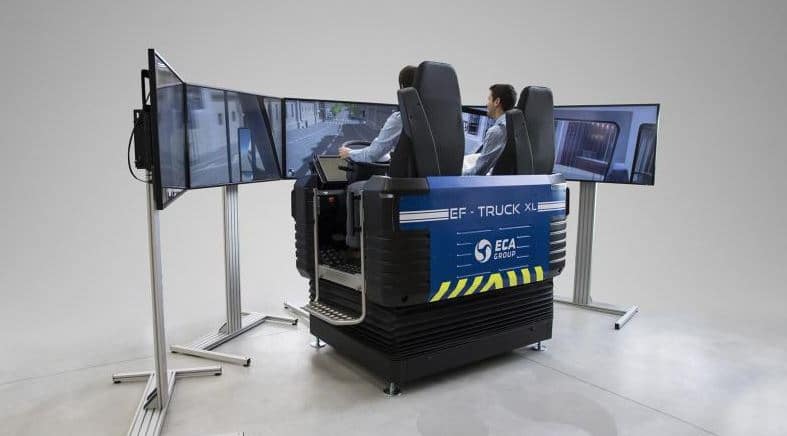2264Views

MILIPOL 2017: EF Emergency – ECA Group unveils its emergency driving simulators
Tuesday, November 21 2017 – TRAINING SIMULATION
EF Emergency is a new range of simulators from ECA Group that increases the proficiency of emergency response drivers and riders. A versatile and modular training tool for professional use, the software is adapted to three occupational categories: Defence, Police and Ambulance.
Urgent interventions are the daily life of police, military personnel, firefighters and ambulance drivers. They often repeat the same action: from the police station, barracks or hospital, they must reach their destination as quickly as possible while guaranteeing the safety of the crew and the vehicle. For the drivers of these priority vehicles, this is a delicate task. On the road, they need to be able to deal with mission stress, the unexpected, speed, the countless obstacles that can arise or block the road, traffic hazards, the behaviour of other road users and many other constraints. They must also have a perfect command of the procedures and vehicles used.
In short, driving in an emergency cannot be improvised!
ECA Group, a specialist in simulators, has taken up the challenge of developing a complete range of emergency driving simulators to provide a high level of performance and thus help companies provide post-license training for drivers and assess them.
This range, named EF Emergency, has been developed with training professionals.
“This is the first time that we have adopted a business approach with an appropriate educational method that takes into account all the very specific constraints of companies’ occupations,” explains Philippe Boulleau, an expert in safe and emergency-response driver training at BBE Développement.
While previous generations of simulators simply simulate the vehicle, environment and virtual driving, ECA Group’s EF Emergency goes further by offering a rich educational content, with a comprehensive series of lessons in images and explanatory diagrams, followed by simulations based on real-life scenarios and assessment exams.
Using a touchscreen tablet, the instructor adapts each student’s program to his or her needs. To test the student’s skills, he can at any time vary the difficulties and modify the environment: traffic density, the type of areas (urban, peri-urban, rural, off-road, dirt tracks), weather conditions, time of day or night, the “competent, incompetent or hostile” social behaviour of road users. It is even possible to trigger accidents and test vehicle dynamics.
“Scenarios and simulations can be varied infinitely. You will never have the same exercise twice,” comments Eric Leroux, EF Emergency’s project manager.
“Increasingly intelligent, the simulators make it possible to unburden the instructor from as many of his non-essential tasks as possible. The instructor cannot be separated from the software because he is in charge of communication, instructions, verifications and validations,” says Arnaud Chevilllot, Sales Director of ECA Group.
Another major new feature is the dual-seat simulation platform, EF Truck XL. This new platform is used to train the entire crew of an emergency vehicle.
“With EF Truck XL, we are now very close to reality. Firefighters and police officers are never alone when they leave for an emergency. The second person helps the driver navigate,” adds the trainer.
ECA Group provides software that makes it possible to simulate a two-person driving team with a choice of over a dozen different types of vehicles:
- logistics trucks,
- lightweight non protected vehicles,
- rescue and victim-assistance vehicles,
- forestry tanker trucks,
- and various fire engines including pumper and turntable ladder trucks.
Moreover, several EF Emergency simulators can be networked together to share the same environment and train for escort, convoy or multi-team missions.
Even if the legislation does not impose any obligation for driving training in emergency situations, many advantages have already won over numerous customers in France and around the world, such as Australian firefighters, the national gendarmerie of Algeria and several French fire and rescue services.
About ECA Group simulators
ECA Group simulators combine precise vehicle modelling with full pedagogy and an immersive virtual environment. This solution makes it possible to increase the efficiency of driver training and thus reduce the risk of accidents and associated costs. Using simulation to replace or supplement the actual vehicle for training also reduces training costs by saving money on fuel and vehicle wear.
Discover ECA Group’s range of Emergency driving simulator (en cours de création)
IMPORTANT
This Press Release was requested for publishing by an external entity not associated with Quwa. Comments, opinions and discussions by external entities are not those of Quwa. Thus, Quwa does not accept responsibility or liability for the content of this Press Release. Quwa does not grant rights to reproduce or use this content. If your company would like to request Quwa to publish a press release, please contact us (link).



